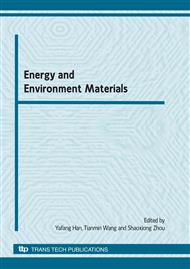p.78
p.85
p.91
p.97
p.103
p.109
p.115
p.119
p.126
Effects of Barium Substitution on the Structure and Properties of PSZT Piezoelectric Ceramics
Abstract:
Piezoelectric ceramics with appropriate curie temperatures and high dielectric and piezoelectric performances are attractive for formations of ceramic/polymer piezoelectric composites. The PSZT ceramics with compositions of 0.98Pb1.0-xBaxTi0.48Zr0.52O3-0.02PbSbO3 (x=0.14~0.24) have been prepared by a conventional solid reaction process. The ceramic structures are analyzed by X-ray diffraction and the barium substitution leads to structural changes of the tetragonal and rhombohedral phases which constitute the perovskite PSZT ceramics, and lattice distortions. The curie temperature almost linearly decreases from 226 °C to 141 °C corresponding the barium content increases from 0.14 to 0.24 in the ceramics. The dielectric and piezoelectric properties are largely influenced by the barium substitution and when the barium content at vicinity of 0.22, the piezoelectric strain constant d33 exhibits a dramatic change. It is found that as the barium content around 0.22, the PSZT ceramic specimen is characterized with a low curie temperature Tc=156 °C, and satisfied dielectric and piezoelectric properties with the relative dielectric constant εr=5873, dielectric loss factor tanδ=0.0387, piezoelectric strain constant d33=578 pC/N.
Info:
Periodical:
Pages:
103-108
Citation:
Online since:
May 2010
Authors:
Price:
Сopyright:
© 2010 Trans Tech Publications Ltd. All Rights Reserved
Share:
Citation:


